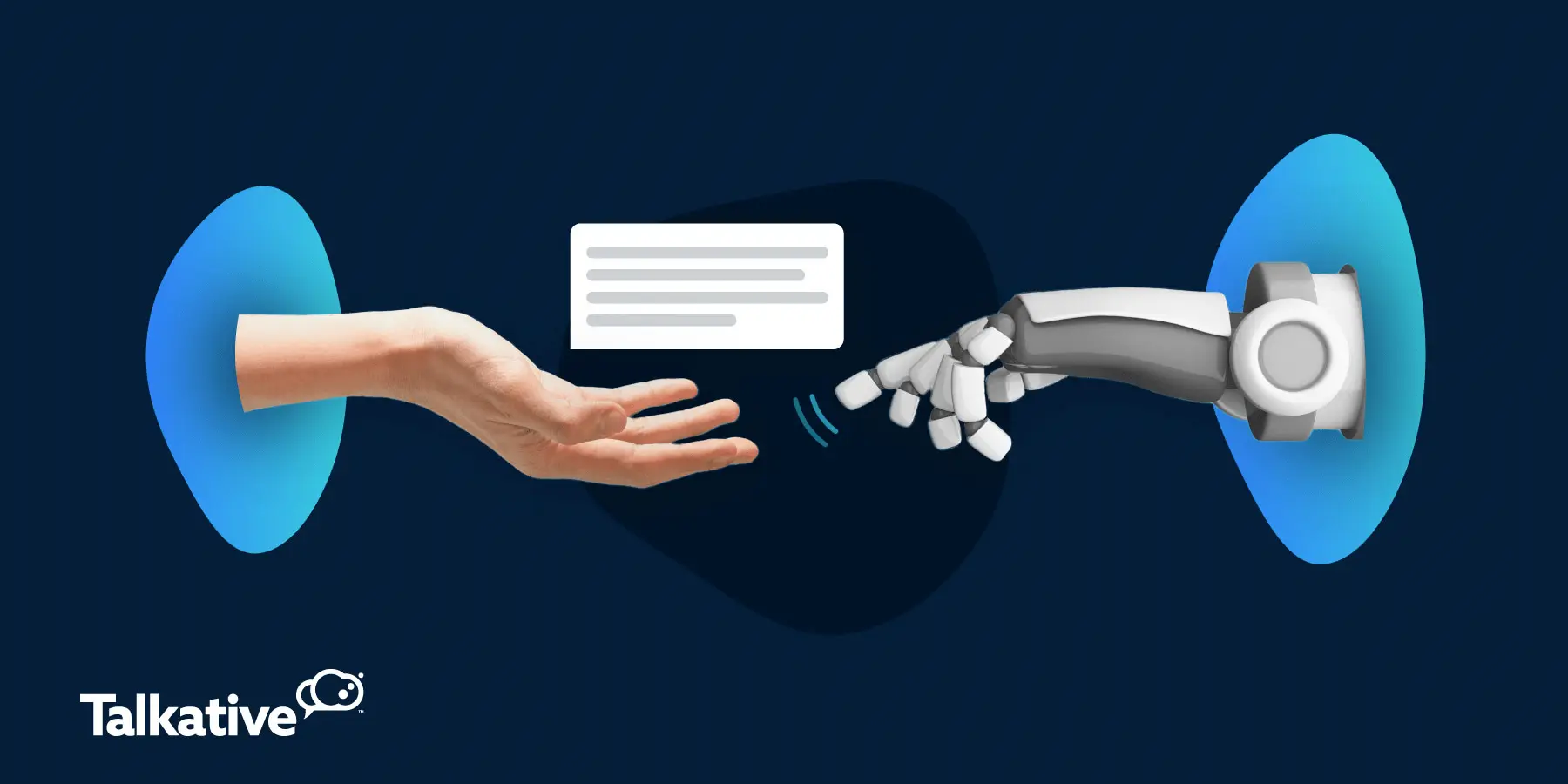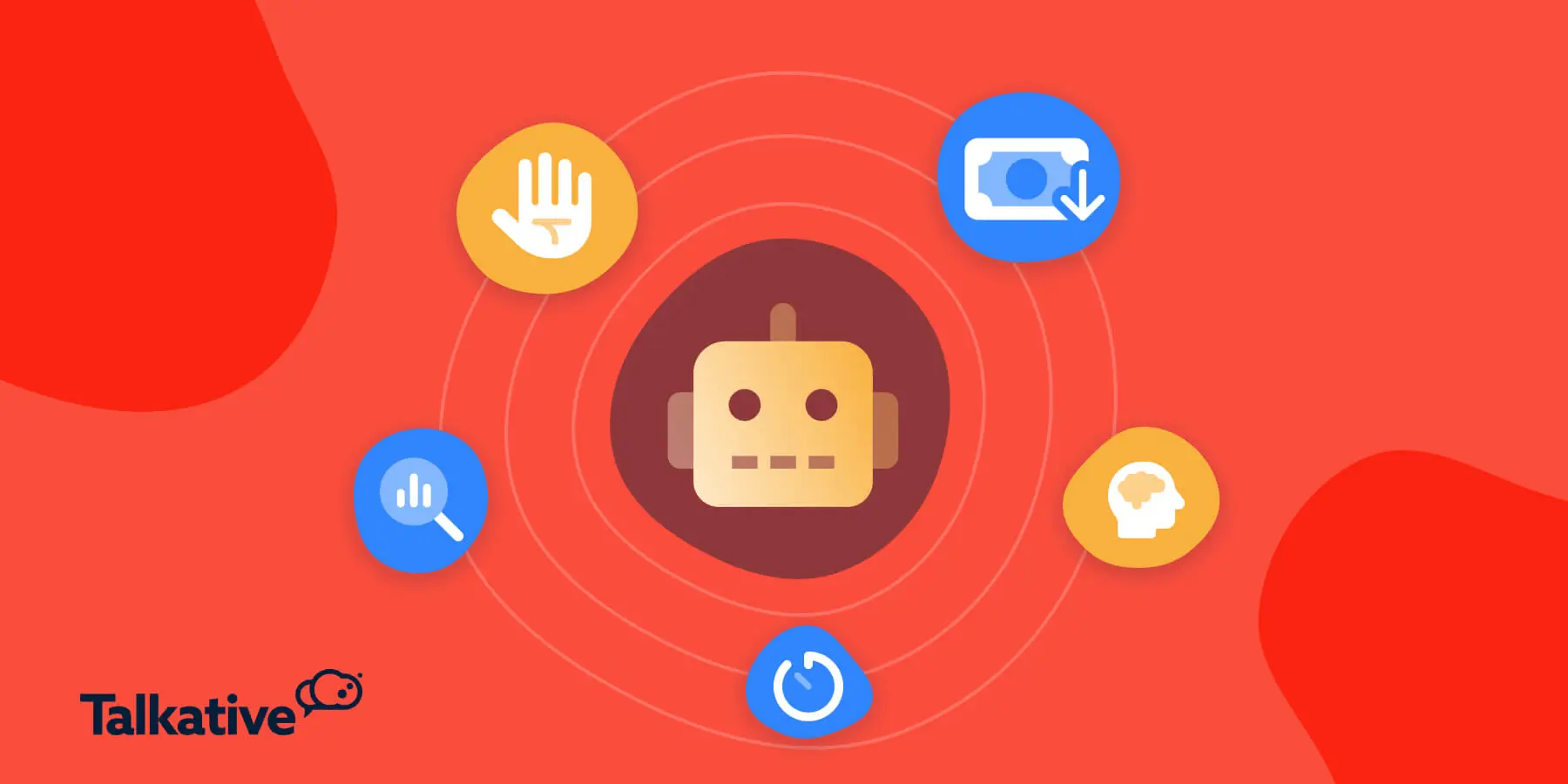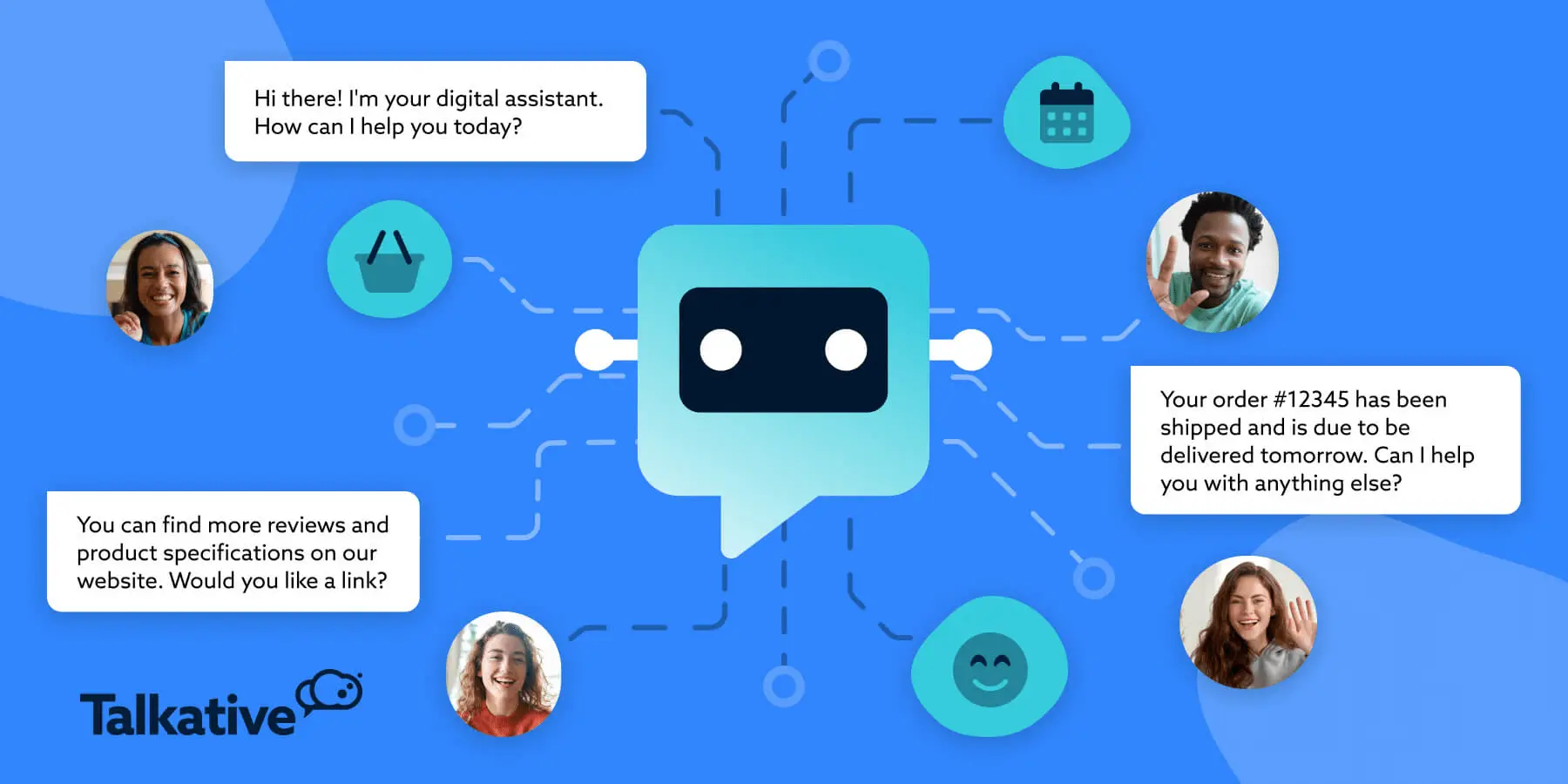The rise of artificial intelligence has transformed customer service.
Conversational AI chatbots, in particular, have surged in popularity - especially since the launch of OpenAI’s ChatGPT.
These systems save businesses time and money by automating customer interactions and tasks.
In the past, users primarily interacted with chatbots via text-based communication.
Since then, advancements in AI technology have made voice conversations with AI agents a reality.
AI-powered voice bots have gained significant traction in recent years.
In fact, 97% of mobile users now use AI-powered voice assistants (e.g. Siri for Apple iOS devices).
This means that most consumers are already familiar with the technology - making conversational AI voicebots an ideal tool for automated customer service.
But what do businesses and contact centers stand to gain from voice AI solutions?
How can they use this technology to improve customer support and operational efficiency?
In this guide, we’ll explore these questions - and more. We’ll cover...
- What are voice AI agents, and how do they work?
- What are voice chatbots and voice assistants?
- Voice AI agents vs. Interactive Voice Response (IVR)
- Key use cases for voice AI agents in customer support
- Benefits of a conversational AI voicebot for businesses and customers
TL;DR:
- Voice AI technology enables natural, spoken conversations between artificial intelligence systems and humans.
- Voice chatbots are built for customer service interactions, while voice assistants (e.g. Siri, Alexa) focus on personal consumer use.
- Unlike rigid IVRs, AI-powered voice bots use technologies like speech recognition, natural language processing, LLMs, and generative AI for seamless interactions.
- Key use cases: call routing, answering inquiries, customer self-service, order updates, appointment scheduling, and multilingual support.
- Benefits include greater efficiency, reduced costs, and improved customer experience.

What is voice AI?
Voice AI is the technology that enables machines to understand and respond to human speech.
It combines various branches of artificial intelligence, such as conversational AI, natural language processing (NLP), natural language understanding (NLU), machine learning models, foundation models, text to speech, and generative AI.
This enables businesses to build AI agents that can interact with users through spoken language in a conversational manner.
Voice AI agents are transforming industries and everyday life by making interactions with technology more human-like.
For businesses, it’s revolutionising AI customer service and automation.
For consumers, it allows users to interact with devices and control their environment hands-free.
As Voice AI continues to evolve, its potential applications and capabilities are continuing to expand.

How does voice AI work?
Voice AI chatbots work through a series of complex processes and technologies...
- Advanced Speech Recognition: The process begins with the system capturing audio input to convert spoken language into text using Automatic Speech Recognition (ASR) technology.
- Natural Language Processing (NLP): The transcribed text is analysed to understand the syntax and semantics of the language. NLP breaks down sentences to interpret context, intent, and meaning.
- Natural Language Understanding (NLU): NLU delves deeper to comprehend the user's intent, even when faced with varied phrasing or ambiguous language. It helps the system handle nuances, slang, and different accents.
- Dialogue Management: This component decides how the system should respond based on the interpreted user's intent and the context of the conversation. It manages the flow of the dialogue to facilitate coherent and context-aware interactions.
- Generative AI: The system formulates and produces an appropriate response in natural language generation, ensuring that the reply is clear and conversational.
- Text-to-Speech (TTS): The generated text response is converted back into audible speech using text to speech technology, allowing the system to communicate verbally with the user.
These steps occur rapidly, enabling developers to build AI agents capable of real-time voice interactions that feel natural and seamless to the user.

What are voice AI chatbots & voice assistants?
Voice chatbots and assistants are intelligent software programs that understand and respond to spoken language.
Although they’re both powered by technologies like conversational AI and text to speech, there are key differences in their purpose and functionality.
An AI-powered voice chatbot is used by businesses and organisations to enhance customer service.
These automated systems are typically integrated into customer service software or platforms.
They’re implemented to act as an AI agent, engaging and assisting customers via telephony or through a company’s website/app.
On the other hand, AI-powered voice assistants (e.g., Alexa, Siri, Google Assistant) are designed for personal use by consumers.
They’re often embedded in devices like smartphones, cars, and home appliances.
From setting reminders and playing music to controlling household gadgets and searching the web, a voice assistant can assist users with a wide range of tasks.
It can understand and execute voice commands, answer questions, provide personalised responses, and even offer suggestions.
Overall, while both voice chatbots and assistants leverage AI to help users, their roles differ in scope and complexity.
One specialises in providing automated customer support on the behalf of a business, while the other is a multifaceted consumer tool for daily assistance and information.

Voice AI vs. Interactive Voice Response (IVR)
Interactive Voice Response (IVR) and voice AI are related customer service technologies.
However, they differ significantly in their capabilities and user experience.
IVR is a traditional telephony system that assists customers through pre-recorded voice prompts and keypad inputs.
Typically, when you call a business and are asked to “press 1 for sales” or “press 2 for support”, you’re using an IVR system.
IVR operates using a menu-based structure. Each option is predefined, and callers are guided through the system step by step.
Its capabilities are generally limited to recognising basic user inputs like numbers or a small set of specific voice commands.
While IVR systems are useful for handling very basic tasks, they can feel rigid and cumbersome.
This is because users must follow a specific path to complete their request, often leading to errors and a frustrating user experience.
Voice AI agents, on the other hand, are far more sophisticated and flexible thanks to artificial intelligence.
They use advanced technologies, like conversational AI and text-to-speech, to offer real-time assistance and interpret and respond to speech in a more fluid, human-like way.
Unlike IVR, Voice AI doesn’t require users to stick to rigid prompts or choose from a limited menu of options.
Instead, users can ask questions or make requests in their own words, which the system can understand and respond to accordingly.
For example, a customer might say, “I need help with my internet connection”.
A voice AI agent could instantly identify the issue from this one statement and route the call appropriately without needing specific words or actions (e.g. pressing a button).
This makes voice AI much more dynamic and user-friendly, simulating emotional intelligence and offering a seamless, efficient, and positive experience.
In short, while IVR relies on predefined menus and precise wording, voice AI allows for free-flowing conversations and more complex inquiries.
That said, the seamless integration of AI can make traditional IVR more powerful, enabling businesses to offer a blend of both technologies.

What are the top customer service use cases for conversational AI voice bots?
Now that we’ve covered the basics of voice AI technology, let’s examine it in action.
Below, we’ll explore 5 key use cases for AI-powered voice bot solutions in customer service.
1. AI-driven call routing
One key challenge for contact centers and customer service departments is effective call routing.
Phone calls need to be routed to the right team or agent for efficiency - but this process can be a pain point for customers.
As we’ve covered, traditional IVR routing requires callers to navigate through multiple layers of menus with very limited or restrictive options.
This often leads to friction, extended wait times, and a poor user experience.
In fact, 55% of customers feel frustrated by IVR as they feel it makes them jump through hoops to get support.
What’s more, 51% will abandon a call entirely to avoid navigating an IVR system.
AI-driven call routing offers a solution to this problem.
Voice AI agents can analyse a caller’s voice, language, and use intent recognition to streamline the routing process.
This means customers can describe their needs or requests in natural language rather than pressing buttons or using pre-set words/phrases.
In turn, the conversational AI agent can listen to a customer query, identify the meaning, and transfer the call to the appropriate department.
This not only reduces the time spent on the phone but also offers a much smoother and more efficient customer service experience.

2. Answering customer inquiries
AI-powered voice bots are increasingly being deployed to handle routine customer inquiries.
These interactions often account for a large volume of customer calls in many industries.
Routine queries can range from asking about product/service availability or pricing details to troubleshooting common technical issues and more.
By leveraging tehcnologies like natural language processing (NLP), generative AI, conversational AI, and foundation models, businesses can build AI agents that are able to comprehend a variety of questions and provide accurate, real-time assistance.
Voice AI agents can also be integrated with your knowledge base, giving them access to a wealth of information about your business, products, services, and processes.
This enables the voice chatbot to become a brand-trained expert capable of answering countless customer questions.
As a result, the number of phone calls requiring human intervention decreases, reducing agent workloads.
It means your human agents will have more time for high-value interactions or complex tasks.

3. Order updates & information
For retail and ecommerce brands, it’s common to experience high volumes of queries related to online orders.
Phone lines are often flooded with customers requesting order status updates, shipping/delivery times, return policy information, etc.
Handling these repetitive queries manually is very time-consuming for human agents, leading to slower service, burnt-out agents, and decreased efficiency.
Conversational AI voice solutions are an ideal fit for these frequent yet essential interactions.
Customers can simply ask a voice chatbot any order-related questions, such as "When will my package arrive?" or “Where is my order?”.
The AI can then request the order number in its response, retrieve the relevant information from your CRM or API, and provide an instant update.
This automated process cuts down wait times and enables 24/7 order updates, ultimately increasing service quality and customer satisfaction.
4. Appointment scheduling
Scheduling appointments can be a tedious task for businesses when it’s done manually.
Voice AI simplifies this process by allowing customers to manage appointments quickly and efficiently.
With a conversational AI bot, customers can self-serve to find available time slots, book appointments, reschedule, or even cancel if needed.
The AI can access your calendar and databases in real time, checking availability and making sure there are no conflicts.
This use case is valuable for a number of industries, for example:
- Travel & Hospitality: Consumers can arrange and manage restaurant reservations, hotel bookings, transport, consultations with travel agents, etc.
- Healthcare: Patients can schedule doctor’s appointments, dental visits, therapy sessions, etc.
- Beauty: Clients can book haircuts, manicures/pedicures, consultations, and other beauty services or treatments.
- Public sector: Citizens can make appointments for various public or government services, such as passport applications and visa renewals.
- Financial Services: Clients can schedule meetings with bankers, financial advisors, tax consultants, etc.
Overall, voice AI streamlines appointment requests and the booking process, saving time for both you and your customers.

5. Multilingual customer service
For global brands or those serving a diverse customer base, the ability to provide support in different languages is crucial.
AI-powered voice agents excel at this by facilitating seamless multilingual customer service.
By leveraging real-time translation technology, an AI-powered voice bot can automatically detect a user’s language and respond accordingly.
This eliminates language barriers and reduces miscommunication, ensuring an inclusive and seamless customer service experience.
It also empowers you to serve a wider audience without hiring human translators or multilingual agents.
Additionally, multilingual support boosts overall customer satisfaction by providing a more personalised and empathetic touch.
When customers can speak in their native language, they feel more at ease, understood, and valued.
Ultimately, real-time translation is a powerful voice AI use case that expands reach, improves accessibility, and ensures clear communication.

What are the benefits of a voice AI virtual assistant chatbot?
As the above use cases show, an AI-powered voice bot can be a valuable tool for customer service.
Below, we'll cover the key benefits you can enjoy by leveraging voice AI.
Humanised automation
One of the standout benefits of a conversational AI agent is its ability to humanise automated phone support.
Unlike traditional chatbots or IVR menus that can feel robotic or impersonal, AI-powered chatbots are designed to engage in natural, human-like interactions.
They can interpret and respond to speech in a way that mimics human conversation, creating a more palatable and personalised user experience.
Another key humanisation feature is the ability to customise your AI’s voice.
Businesses can choose from a diverse library of pre-configured voices or clone the voice of a specific person (e.g., a staff member or brand ambassador).
This allows you to match the tone, gender, and accent of the AI agent with your preferences.
Preferred AI voice configurations can vary based on industry, brand identity, and customer demographics.
Whether it’s a calm and soothing voice for healthcare services or an energetic, friendly tone for retail, this customisation helps foster a stronger connection with users.

Efficiency gains & cost savings
Efficiency is an area where a voice AI agent excels.
As we’ve covered, organisations that build AI agents using voicebot technology can automate a variety of customer service use cases.
This boosts efficiency by automating interactions and tasks that would otherwise require human intervention.
Moreover, unlike humans, one AI system can manage hundreds or thousands of calls concurrently.
This means you can scale your customer support operations without hiring more human agents, also increasing chatbot ROI.
These efficiency gains and labour savings create a far more cost-effective support system.
Case in point, contact centers across industries experience up to a 50% reduction in operational costs by using voice AI.

Improved customer experience
AI-powered voice bots improve the customer experience by providing fast, accurate responses, and convenient solutions.
They minimise the frustration customers endure when navigating through complex IVR menus or waiting on hold for extended periods.
Instead, customers can ask their questions naturally and receive immediate responses.
Voice AI systems also offer sophisticated and accessible self-service.
From providing real-time information to troubleshooting common issues and booking appointments, AI empowers customers to resolve many inquiries themselves.
And in cases where a customer does need human support, AI-powered routing ensures seamless escalation to the most appropriate agent or team.
This ensures that customers are always directed to the right resource without unnecessary delays.
By providing exceptional automated service in a humanised way, voice AI enhances telephony experiences, service quality, and customer engagement.

The takeaway
AI voice agents offer an innovative and humanised approach to AI customer service.
From intelligent call routing to conversational self-service, this technology can significantly boost efficiency and enhance customer experiences.
That’s why we’ve released our own voice AI solution.
Designed to deliver a seamless, accurate, and friendly experience at every voice touchpoint, Talkative’s voice AI offers...
- Humanised AI conversations: Choose from a library of voices or use your own to automate a personalised customer experience.
- Easy setup & management: Build, customise, and train your voice AI agent with custom AI prompts and private AI Knowledge Bases.
- Multilingual support: Serve customers in multiple languages at any time of day or night, freeing your agents up for cases that need the human touch.
- AI analytics & reporting: AI-generated transcripts, AI interaction summaries and reports, chatbot analytics, knowledge base insights, and more.
With our solution, you can replace clunky IVRs, optimise call handling, and provide 24/7 phone support with the warmth of a human voice.
In addition to voice AI, we offer AI across multiple channels - including live chat, chatbots, messaging, email, and more.
Want to learn more?
Book a demo with Talkative today, and check out our interactive product tour.

.png)

